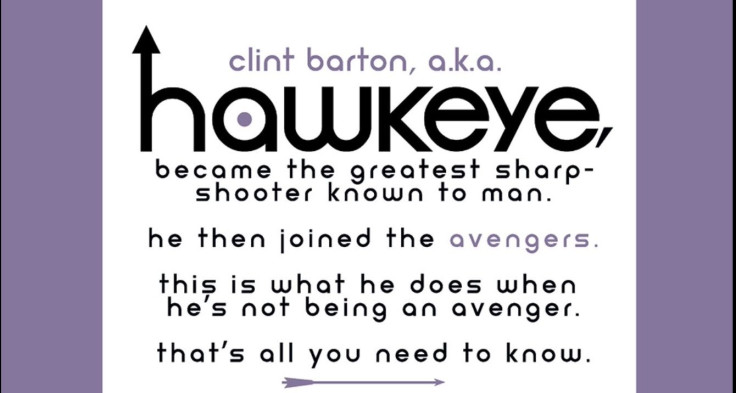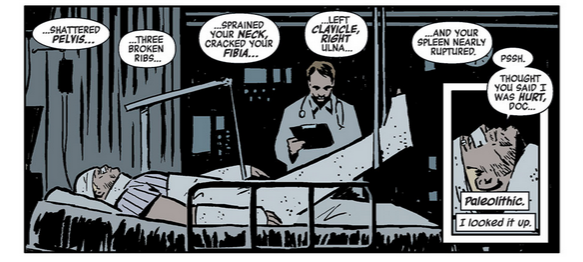Marvel's 'Hawkeye' Comic Book Series Ends Today With A Poignant And Satisfying Final Chapter

You remember how "Avengers: Age of Ultron" tried to make you care about and relate to Hawkeye (Jeremy Renner) by revealing he had a pregnant wife, two kids and lived on secluded farm? The intent, to make him the everyman of the movie, was admirable, but the execution was kind of clumsy and slowed the movie down. If you want to see how that should be done, check out Matt Fraction and David Aja's award-winning series "Hawkeye," which ended on Wednesday.
After months of delays, Hawkeye #22, has finally hit stands, bringing this team’s groundbreaking series to an emotional and satisfying close. It's the conclusion of the battle of Bed-Stuy between Hawkeye and the Tracksuit Draculas, the hilariously nicknamed Russian gang whose members wear tracksuits and say bro every other word.
With an emphasis on character-driven storytelling, the series solidified Hawkeye as one of Marvel’s most relatable characters. He hasn’t gotten nearly as much attention on screen as he should, so if you’re a Hawkeye fan, this is definitely the book for you. Actually, this book is worth checking out whether or not you’re a superhero fan too, because it’s a very un-superhero like book about a superhero. (Also, every issue except for #22 is available for free on Marvel Unlimited).
Debuting in 2012, Fraction and Aja’s “Hawkeye” series carries a simple premise that’s succinctly outlined on the first page of each issue:

When he isn’t with the Avengers, he’s the Robin Hood of Bed-Stuy, Brooklyn, where he lives. And, instead of trotting across the globe like James Bond (save for two issues) and fighting intergalactic Big Bads, the series finds Clint, alongside his headstrong foil and partner/protégé Kate Bishop who also goes by the alias Hawkeye, facing off against the Tracksuit Dracula, who are trying to evict him and his neighbors from their apartment building because they want to demolish it and construct "Manhattan's premier luxury shopping destination." There’s also no secret identity shenanigans and his neighbors don’t fuss about him being a superhero.
Hawkeye #22 is a poignant ending to an already poignant and impressive story. Aja’s art, which emphasizes facial expressions and the quick impact of every punch and bullet, makes the dialogue light issue very intimate and like an action movie. Motifs from earlier in the series, like the boomerang arrow and Hawkeye’s collar-stay, return to highlight how far our characters have come. Clint spent most of the series pushing everyone close to him away, so it’s moving to see him surrounded by them again in the end. However, the final panels remind us that this was story about Clint and Kate, and it ends with them silhouetted as they fire off arrows in unison like they’re in stylized end credits of a movie.
Over the course of 22 issues, the series experimented with and pushed the boundaries of the medium. There was entire issue told from the perspective a dog, which went on to win an Eisner Award, the Emmys of comics, in 2014. In the issue #19, a doctor informs Clint that an altercation with an assassin working for the Tracksuits has left him deaf, which leads to a significant portion of the issue being told through American Sign Language and speech bubbles being empty because Clint can't hear what other characters are saying. Even in "normal" issues, the storytelling was narratively complex and played around with the sequencing of events, which required the reader to pay very close attention.

In Kate, the series quickly found its co-lead, who was just as stubborn and impulsive as her mentor. Her life was almost as messy too. Midway through the series, she heads off to California on her own. Every other issue was about Kate's California escapade, which was great because she such a well-developed character that we didn't mind spending entire issues with just her and no Clint.
What made “Hawkeye” so special, as The AV Club’s Oliver Sava explains, is that it casts Hawkeye as Marvel’s new everyman. We spend just as much time with Clint as Hawkeye as we do with him having a cook-out on the roof of his apartment with his neighbors. Even though he’s a superhero, his life is still a train wreck and much of the series is concerned with him struggling to clean it up. We see him get severely injured in many issues, screw up almost every relationship in his life, pushing those close to him away and work through his childhood trauma. Nevertheless, he still insisted on helping people out, and, at the end of the day, it was comic about trying to do right and be the person you can be in spite of everything else.

“He’s so futzing relatable,” Sana Amanat, an editor at Marvel, wrote in a letter at the end of Hawkeye #22. “Maybe we don’t have those archery skills, the perfect aim, or the ability to take that many punches—but when we do get knocked down, we all want the invincible determination to get back up. And man, Clint had to do that a lot in that this story.”
Don’t worry, this isn’t the last time we’ll see Hawkeye. He and Kate are starring in “All-New Hawkeye,” a new series written by Jeff Lemire (“Green Arrow”) and art by Ramon Perez ("Wolverine And The X-Men"). Clint's Bed-Stuy apartment doesn't make an appearance until the third issue, but that's okay, because there's plenty of hilarious Clint-Kate banter. It's all good, bro.
© Copyright IBTimes 2025. All rights reserved.






















